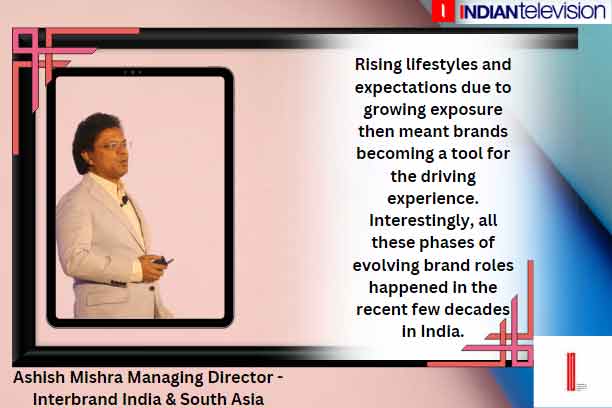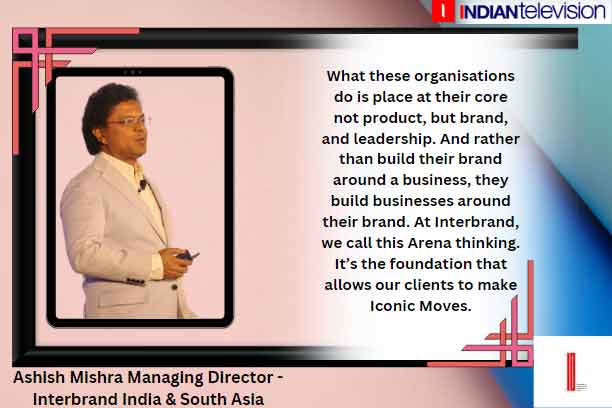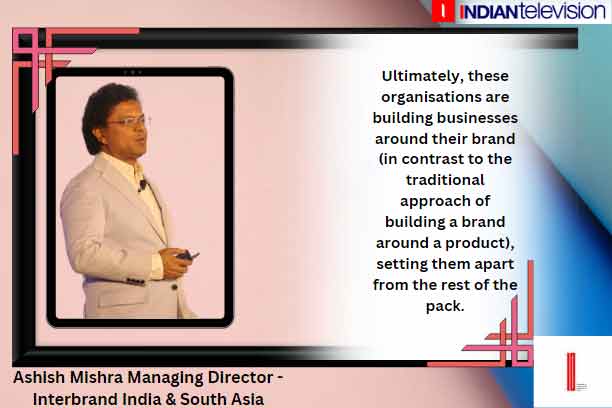Mumbai: In today's world of brands and more brands, what stands out is the brand identity, it can make or break a brand. This is where Interbrands steps in, it has been the world’s leading brand consultancy, for over 40 years – having pioneered iconic work and forged many of the brand-building tools that are now commonplace. We know that in an age of abundant choice and speed of innovation, customers’ expectations are moving faster than businesses.
While incremental change is still essential, it’s no longer sufficient. It takes bold moves to leap ahead of customers and competitors. We call these moves iconic moves. In collaboration with many of the world’s leading brands, our global team of thinkers and makers is pioneering the future of brand building.
By turning customers into active participants, Interbrand helps clients strengthen their brands on an ongoing basis – our approach gives them the confidence to make iconic moves that spark desire and create utility, and driving.
Interbrands is celebrating its 10th year, the Best Indian Brands report has become a definitive guide to the nation's brand landscape since its inaugural publication in 2014. This year's edition showcases remarkable growth, with a total list value of INR 8,310,057 million (US$ 100 billion), marking a significant 167% increase over the past decade. Notably, this is the first time the total value of the table has surpassed the US$ 100 billion mark.
In a short span of five years, with Ashish at the helm, the world’s leading Brand Consultancy has emerged as a clear leader in the Indian market as well. The top five branding assignments of India, Godrej, JIO, Mahindra Global Brand, Britannia and Infosys; are the top 5 projects of Interbrand India too. He has built the business by building strong relationships with a third of the top 40 Best Indian Brands, including Reliance, Britannia, Infosys, Godrej, Mahindra, Bajaj Auto, JSW, Ashok Leyland, HPCL, Tata, HCL, L&T and Union Bank.
An author, a social commentator and columnist, a Culture Brand exponent, an entrepreneurial businessman and one of the eminent Branding Thought Leaders of India; Ashish has led or played a decisive role in some of the most acclaimed brand creations or makeovers of the recent times. His portfolio includes Corporate Branding of PepsiCo GNG, Rebranding of the Godrej Group and Britannia, Repositioning of Infosys, Branding of JIO, Laying a roadmap for Mahindra’s global brand ambition, Makeover of Union Bank & XLRI, Creation of a new Brand for Etisalat, Branding of Baroda Next & Godrej Expert Hair Colors, Decisive Repositioning of Godrej No 1, Building of Real Good Chicken & Yummiez and Brand Design for Reliance Metro among others.
After instituting and heading the Strategic Planning function at DDB Mudra for a decade, Ashish set up and successfully ran Water, a strategic branding & design consultancy now Interbrand India. He is a regular invitee at the important brand forums in the region and is now busy building adjoining markets of Sri Lanka and the Middle East for Interbrand.
Indiantelevision.com in an email interaction with Ashish Mishra Managing Director - Interbrand India & South Asia on the journey of Interbrands, on working with various brands, on this year’s valuation of the top 10 brands and much more……
Edited excerpts
On the journey of Interbrand since its launch a decade ago and change in mindset by brands over the years?
In our 10 years, we have seen, and if may somewhat presumptuously add, catalysed, an intense evolution in the way Indian Organisations thought about their brands. It may not be too wrong to say that our real understanding of brands and branding has begun only in the last few decades. Let me explain why. First up, the historic evolution the world organically went through was missed by us due to our being a colony. Post-independence we were catching up and working hard to bridge the basic scarcities and gaps. For 5 odd decades, we had a protected and closed market.
With the economic reforms and the telecom revolution of the 90s, we opened up to the world. That’s when we got on to the real change or should I say ‘universalisation of branding’. In the recent decade or so, we saw India going through the longer phases of branding role evolution rather quickly. Pretty much doing a crash course of cramming the evolutions the developed world went through over a century into a very short period of time.
So, what are these changing roles, the Brands have gone through, one may ask.
When production was the priority to meet the pent-up demand for a society bypassed by industrialisation, brands signalled material trust versus the unbranded. This went on for decades.
With the opening up and the global brands entering, the base quality became table stakes, and the brand became a way to create premium and value. With prosperity growing and socio-economic classes spawning a new caste system, brands began reflecting elitist identification to drive businesses.

Rising lifestyles and expectations due to growing exposure then meant brands becoming a tool for the driving experience. Interestingly, all these phases of evolving brand roles happened in the recent few decades in India.
Now, the new world has hyper-connectivity but lesser connections, extreme information but rare original thought, many fundable start-ups but few sustainable commitments, wide social networks but lesser depth of anchorage in culture and value systems, long friend lists but deeper aches to belong, savvy political tokenisms but growing trust deficits with governments.
These and many more simmering sociocultural tensions precipitated by the pandemic are signs to recognize by Brands. Because providing a resolution for these through fresh ideologies, narratives, experiences, ethics-in-action and proximate presences will create the highest order of connections for brands. These will be the New Acts of Leadership. And this will be the new role brands can play in the new world.
On Interbrand working with the best brands
Yes, it has been an extremely interesting journey.
Beginning with the first large assignment of rebranding Godrej and working closely with Tanya, and often being the only two culturally connected, grounded Indians in the Interbrand core team discussions with the Interbrand London team. Sometimes amused, sometimes inspired. Or the extended Brand Council workshops and meetings at Mahindra to chart out a 7-year plan to be a top 50 globally admired brand.
Or the round-the-clock meetings at the earmarked ‘consultants’ floor’ at Reliance Belapur Campus, the long waits at Antlia over the amazing Gujarati buffets for finalising the branding of Jio with the family.
Or the many sessions over two years with Mr Wadia presiding over the rebranding of Britannia, and rightfully holding up his contrasting views vs. ours, Varun and the teams at the final stages of the rebrand, and of course, prevailing!
Or the historic step-up of the brand at the cusp of change at Infy, with Nandan as the interim in charge of even branding decisions between Vishal’s exit and Salil’s joining.
Or the Iconic Move made with Dheeraj Hinduja and the Leyland leadership team to rebrand Optare into Switch Mobility, the new iconic double-decker electric buses in Mumbai.
Or the chartered flights of Pawan Munjal to our NY office for Branding discussion and our late-night calls to finalise the future of the mobility brand of Hero – Vida.
Experiencing the true first-world cultures in freezing Stockholm while rebranding true caller or envying the cool fun of sports firms while branding & architecting the IPL franchises – Royals and Capitals.
On the total brand value of the top 10 brands is higher than the 40 in the list this year
This is precisely where the exponential growth we see across the ‘super league’ of brands begins. Built on a foundation of exceptional experiences and strong integrity, these brands can expand in multiple directions, with far more freedom and fluidity than traditional diversification. It’s not a question of ‘we do this, we can do that too’, but ‘you trust us, and here’s what else we might help you do.’ Over the past decade, our study of the Best Brands confirms this.
Consider Apple or Google or closer home Jio. It’s hard to fit them within categories (what they do) – things get clearer when taking the perspective of customer jobs to be done (what they help us do). Apple helps us Connect, Do, Belong, Play, Pay and – more recently – Thrive. Rumour has it that soon it may help us Move, too. Google helps us Learn, Connect, Move, Pay, Work. Entertain. Shop. So does Jio. JSW extending its brand into Cement and Paints does feel like Arena play while Asian Paints and Ultratech clearly have begun to play in the broader space of beautiful homes and Homebuilding respectively.

What these organisations do is place at their core not product, but brand, and leadership. And rather than build their brand around a business, they build businesses around their brand. At Interbrand, we call this Arena thinking. It’s the foundation that allows our clients to make Iconic Moves.
On the technology industry surging in the recent past
The digital-first approach becoming an imperative for all and the tech-everything, everywhere, the all-the-time reality of our times means we will be soon at a point where it would be difficult to have a standalone tech category. Simply because everything will be infused or even led by it. Healthcare will be health tech, finance will be fintech, sports will be sports tech and so on.
On the FMCG sector leading the pack, your thoughts on this?
We are a sixth of the world’s population. Our consumption market is our biggest strength. With greater prosperity and the premium segments holding up better even in the downturn, we are seeing value growth in the consumables. With the economy improving and rural/semi-urban demand coming back, we will see greater growth. This is also the space where brands have a higher role.
On the trends seen globally
For the first time ever in 2022, the average brand value of a Best Global Brand has reached over US$3 trillion. The overall value of the Top 100 brands has reached US$3,088,930m, a 16% rise from 2021 (US$2,667,524m). This year sees the fastest rate of brand value growth ever recorded, demonstrating the growing contribution a company’s brand has in driving its economic success.
While financial markets have shown significant swings over the last few years, the value of the world’s strongest brands has steadily increased driving customer choice, loyalty and margins.

Ultimately, these organisations are building businesses around their brand (in contrast to the traditional approach of building a brand around a product), setting them apart from the rest of the pack.
On India faring post-pandemic when compared to the Western markets
While as an economy we have enjoyed relative insularity and higher growth, as the ‘Super League of Brands’ the global counterparts have done better than Indian top brands. The global super league has shown greater confidence in displaying the New Acts of Leadership, played more strongly in the broader Arenas. That said we have had fine examples in the likes of Jio. Isn’t it amazing that Jio raised 11 Bn USD in the thick of pandemic and has emerged to be India’s exemplary Arena Brand taking on the likes of Amazon, a powerful global Arena brand?






